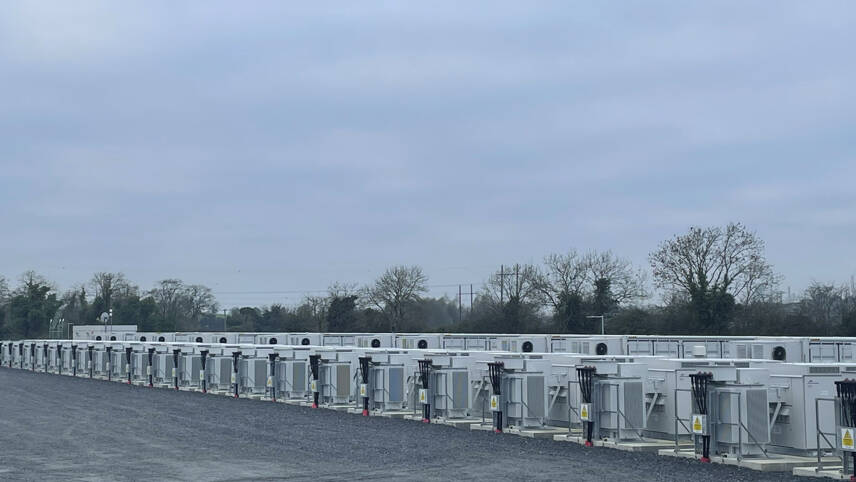Register for free and continue reading
Join our growing army of changemakers and get unlimited access to our premium content

Pictured: The facility in Ireland, called the Gorman project
The 50MW system in County Meath has begun operating in full today (30 June). It will provide grid system services to EirGrid, Ireland’s state-owned electricity transmission operator, for six years, balancing supply and demand.
Energy storage and flexibility will be key to maintaining energy security as more renewables come online, to address the variable nature of generation. This is particularly crucial as sectors such as road transport electrify, increasing electricity demand. The new system is Ireland’s first grid-scale array as the nation works towards 70% renewables in the electricity generation mix by 2030.
A total of €28m has been invested in the project, which covers the size of one football pitch, by the private sector and public finance. The project notably was a successful applicant to EirGrid’s DS3 Capped System Services Contract auction in 2019, designed to support the development of battery projects up to 50MW with fixed-term contracts of six years. Initially, EirGrid was asking developers to bring successful projects online by September 2021. That deadline was extended in light of Covid-19-related disruption.
“Ireland has set out major ambitions to halve emissions by the end of this decade and achieve net-zero by no later than 2050, so investing in the infrastructure needed to help turn that vision into reality is vital if progress is to stay on track – and we’re proud to be part of that journey,” said Iberdrola’s chief executive for the UK and Ireland Charlie Jordan.
Storage in Salisbury
In related news, energy company SSE has forged a partnership with technology group Wärtsilä on the delivery of a 50MW energy storage system in Salisbury, Wiltshire.
The system is expected to come online in September 2023, with planning permission having been granted and with the order having been booked earlier this year. It will provide grid balancing services to National Grid.
“The UK can capitalise on its massive potential for renewable energy by building more of it right now, but energy storage must not be overlooked – effectively balancing the intermittency of renewables is the missing part of the net-zero puzzle,” said Wärtsilä Energy’s vice-president for Europe and Africa Kenneth Engblom.
“If properly deployed, energy storage will enable the grid to deal with fluctuations in renewable energy supply and ensure that the end-users of energy have secured power supply as we switch to cheaper, cleaner energy.”
Figures released in April by RenewableUK confirmed that the UK’s energy storage pipeline is growing rapidly and has surpassed 32GW for the first time, doubling within 12 months. This “staggering” growth was partly attributable to a decision to relax planning rules, first announced in summer 2020 and enacted in December 2020. The change enabled local planning authorities to make decisions on larger projects, lifting the previous 50MW cap for England and theprevious 250MW cap for Wales, after which point Government intervention was previously needed.
SSE is notably planning to invest at least £24bn in the UK’s electricity infrastructure system by 2030, including at least £12.5bn to be spent on decarbonisation-related projects by 2026. Battery storage is a key focus in these spending plans, alongside renewable generation, network upgrades and carbon capture and storage (CCS).batt


Ah—those units again!!!!!
MW, mega.watts, is a measure of the rate of dissipation of energy. The watt is one joule per second, it may be regarded as heat or other energy.
The amount of energy to be stored in a battery is watts.x.time. This would be, perhaps mega.watt.hours or mega.watt.days.
Tricky things, units!!
Richard Phillips